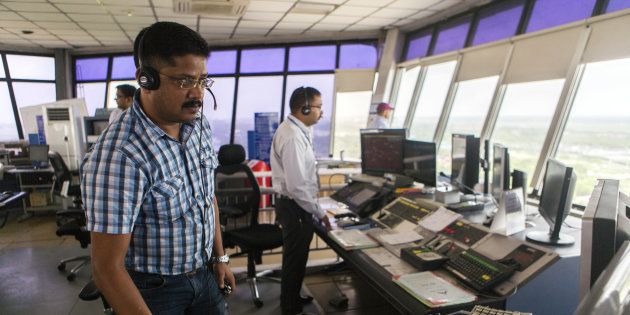
India has just plowed $50 million in a new 102-meter (335 feet) air-traffic control tower in New Delhi. Now comes the hard part: finding qualified flight controllers to operate it.
Designed by HOK, the same firm that drafted Apple Inc.'s research headquarters in California, the tower will be operational in about six months. Yet, it may struggle to handle more flights without enough controllers, according to aviation officials. The nation's busiest airport needs 600 of the technicians ideally for stable operations, but employs only 360, the officials say.
The world's fastest-growing major aviation market is grappling with a paucity of traffic controllers to meet growing demand, as many of them shun employment with the state-run Airports Authority of India, where starting monthly salaries can be as low as $250, and choose monetarily rewarding jobs with private airlines. About a third of India's planned air-traffic controller positions are vacant, the government said last year.
The shortfall has meant existing ATCs are overworked.
"It is a huge safety hazard," said Mohan Ranganathan, a former commercial pilot and an independent aviation safety consultant based in the southern Indian city of Chennai. "The air traffic controllers are being flogged in violation of fatigue rules."
Safety Rating
The dearth of talent in the world's second-most populous country is threatening to reach crisis proportions as a slew of budget carriers unveil plans to add hundreds of aircraft to cater to the travel boom fueled by rising incomes and lower fares. Adding to the challenge is Prime Minister Narendra Modi's ambitious programs to connect smaller towns and villages by air.
The situation came to a head when the U.S. Federal Aviation Administration downgraded India's aviation safety rating in 2014, concluding the nation couldn't find enough officials to ensure safe operation of flights. The U.S. regulator said India's oversight processes don't meet global standards, putting the country on par with Zimbabwe. The ranking was restored a year later following some corrective action to address shortcomings.
Expanding Fleets
Even so, the air-traffic controller shortage will only intensify in the coming years as local carriers buy more planes. Boeing Co. estimates India will need 1,850 aircraft valued at $265 billion over the next two decades.
At least 709 planes are already on order. Go Airlines India Pvt. said it will buy 72 A320neos from Airbus Group SE at Farnborough last month. SpiceJet Ltd. is in talks for 150 aircraft and IndiGo, the nation's biggest carrier, has ordered 430 Airbus narrow-body jets on top of more than the 100 it already flies.
"There is a huge disconnect between what is required in terms of infrastructure, both physical and manpower, and what is being planned," said Kapil Kaul, South Asia CEO for Sydney-based CAPA Centre for Aviation. "We are heading towards a serious infrastructure shortage but choose to ignore reality."
A new aviation policy unveiled in June by Modi is also fueling carriers' expansion plans. In the making for more than a decade, it aims to revive hundreds of unused Indian airports, and provide subsidy to airlines that fly to remote areas. More routes, more planes mean more controllers.
Few Facilities
The problem is not just limited to India. By 2030, the world will need another 40,000 air traffic controllers to handle flights, according to the International Civil Aviation Organization. Yet, there are so few training facilities in Asia, the fastest-growing travel market, that the region will have a deficit of more than 1,000 controllers each year, ICAO said.
The Indian government is in the process of hiring as many as 600 air traffic controllers, who will be trained at three facilities across the country, but only about 60 will be deployed in New Delhi, according to airport officials.
The new policy has a passing mention of an intention to set up a "world-class training centre" for local and overseas air-traffic officials. It still has no clear and well thought out strategy to build skills and capabilities, according to CAPA.
"It is surprising that the ministry of civil aviation hasn't felt the need for more stringent supervision and review of manpower," said Jitender Bhargava, a former executive director of flag carrier Air India. "The problem is systemic and unless accountability is introduced, the vicious cycle of shortages will continue."